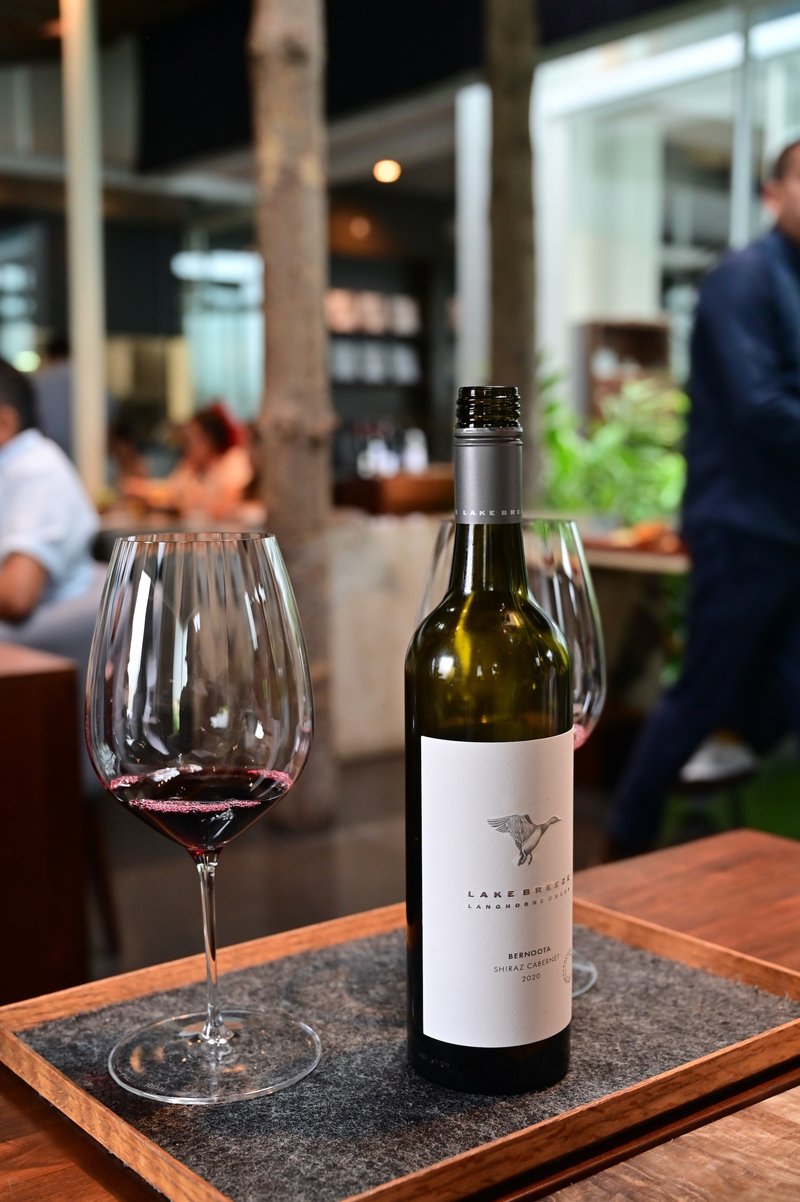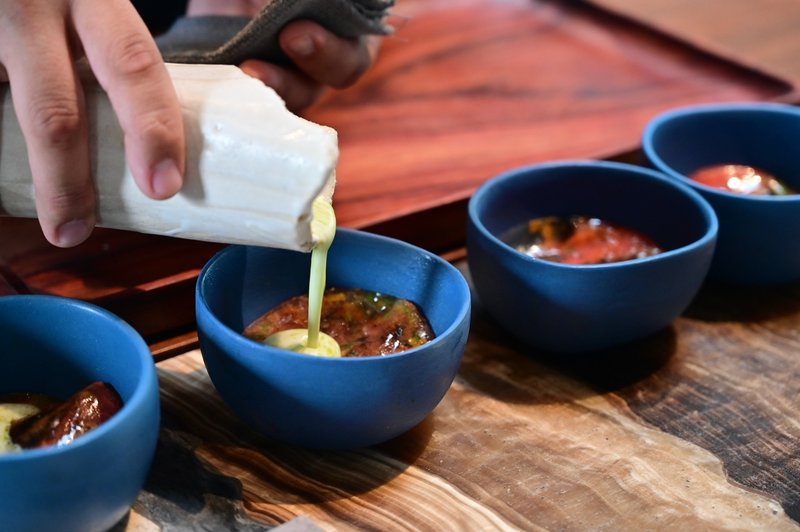
ペルー編3:Central 母なる世界メニュー後半
2023年2月14日、ペルー・リマのレストラン「CENTRAL」でいただいた全14品の「Mundo Matar(母なる世界)」メニューのレポートもやっと終盤。
これまでに6品、ペルー海流からアマゾン熱帯雨林、砂漠の谷、アンデス山脈まで、4000mを超える標高差と異なった地勢がもたらす未知の食材を使ったマジカルな料理をジェットコースターのように味わってきた。
English follows Japanese.
建物内の写真を撮り忘れてしまったが、Centralは広大な敷地に建つ建物の一部を占めているに過ぎない。Centralのサロンとキッチンの奥には、小学校の理科実験室を思わせるガラス張りの研究室「Mater」がある。そこにはペルー全土から集められた植物や様々な食材がガラス瓶などに入れて保存され、美しくディスプレイされている。更にその横には地元の陶芸家たちによる食器の膨大なコレクションも並んでいた。そして、階段を登った2階にはヴィルヒリオ・シェフの奥さまピア・レオン氏がメイン・シェフを務める別のレストラン「Kjole(キホル)」が入っていた。

とにかくどこもコンクリートとメタリックな金属と透明のガラス張りで、外からの光が入り込み、明るく、広い。このポストモダンで贅沢な造りの建物に慣れてしまったら、もう東京の狭くて天井の低いレストランでは満足できなくなってしまいそうだ。
太平洋の蛸と海藻
続いての7品目「青緑の海:海抜0m 帆立貝、ホンダワラ、きゅうり」は日本の居酒屋で出てきてもおかしくなさそうな小鉢料理だった。乾燥させた帆立貝とヒジキに似た海藻ホンダワラを油で揚げたチップスに、ビーツで赤く染めたキュウリの細切りをのせてある。ふたたびカリカリ、シャキシャキの対比である。

ワインは一旦赤に進んでいたが、再び白ワインに戻ってきた。ポルトガル北部ドウロ地方ダンの白。僕は音楽の仕事で2021年、2022年と2年連続でポルトガルを訪れ、仕事の合間に美味しい料理を食べ歩いた。拙著「マージナル・フーディー・ツアー」にも記したが、リスボンにある「The World's 50 Best Restaurants 2023」で第26位に選ばれているレストラン「BELCANTO(ベルカント)」でも、鰻の料理に合わせて、ダンの白ワインをいただいた。30数種類の葡萄が混在している畑からのパワフルな白だ。

そんな芳醇な白ワインに合わせた8品目は「海の頭脳と海藻:海抜マイナス5m 蛸、アオサ、クロミル」。
海の頭脳とは蛸のことを指す。煮ても、焼いても、揚げても、どう調理しても美味しい蛸だが、その知性や能力は今なお謎に包まれている。蛸と人間との一年以上にわたる親密な交流を描き、アメリカ・アカデミー賞を受賞したドキュメンタリー映画『オクトパスの神秘:海の賢者は語る』は必見だ。さて、この料理は一旦柔らかく煮てから、表面をカリカリに焼いた蛸足に、乾麺に見立てたアオサの天ぷらと生のクロミルを合わせてある。カリカリ、ムニュムニュの蛸にパリパリのアオサの組み合わせ、味の対比もさることながら、ヴィルヒリオ・シェフの料理は食感、食材のテクスチャーの対比が興味深い。さらに見た目、色の対比も美しい。この料理なら蛸の赤紫とアオサの薄黄緑だ。


メインは海抜3750m産のジャガイモ原種を粘土焼き!
6杯目はオーストラリア産のシラーズとカベルネソーヴィニョン。いかにも太陽光をたっぷり浴びたフルボディ。当然、こんな王道赤ワインには肉料理が出てくると思いきや、ここでも一捻りあった。

9品目の料理は「MIL CENTRO(ミル・セントロ):海抜3750m 原種のジャガイモ、 チャコ(可食性の粘土)、高山のハーブ」。
ミル・セントロとは、ヴィルヒリオが海抜3750mのアンデス山脈中に新たにオープンしたレストラン兼研究所の名前でもある。セントラルではペルー全土の食材が使われているのに対し、ミル・セントロはアンデス山脈の食材に特化している。ザ・ハーブズメン一行は今回、ミル・セントロも訪れるつもりでいた。しかし、当時ペルー全土で激化していた反政府デモにより、アンデス山脈の入り口であるクスコ空港が閉鎖されてしまったため、直前に予定をキャンセルせざるを得なくなった。


さて、そのお店の名前が付いたこの料理は、アンデス原産の小さなジャガイモをハーブとともに可食性の粘土で覆い包み、庭の一角に設置されたアースオーブンのワティアで、焼けた石や土を被せて地面に埋めて蒸し焼きにしたものだ。カチカチに固まった粘土を割り、中から取り出した小さなジャガイモを口に入れると、ネットリしたジャガイモにレモングラスとローズマリーとタイムを足したような未知のハーブの香りが付いていた。ジャガイモ自体の味も不思議なほど濃くて、濃厚なオーストラリアの赤ワインに負けていないのだ。これは今も千種類以上のジャガイモが残っているペルーならではの食体験ではないか。いつか本家のミル・セントロも訪れねば!

ここまでインターナショナルなワインが続いていたが、7杯目にしてついに地元産のワインが登場した。しかも素焼きの壺「クヴェヴリ」を使って作られたナチュラルのオレンジワインだ。味はいかにも今時のデリケートな酢のようなオレンジ。
南米にはチリとアルゼンチンというワイン大国があり、ペルーではワインよりもピスコと言われる葡萄の蒸留酒が主流だが、近年、ペルー国内からも若い作り手によるこうしたナチュラルワインが少しずつ出てきているのだそう。

アマゾン川のピラニアとスイカの茶碗蒸し
「次はアマゾン川のプレデター、ピクーです」
そう言って、またまたウェイターが防腐加工した不気味な食材の置物を運んできた。見ると鯛ほどの大きさの魚の頭に人間の犬歯のような鋭い歯が並んで付いている。これはピラニアだ!

10品目は「アマゾンの水:海抜190m ピクー(ピラニア)、スイカ、コカの葉」。グロテスクな置物を見せられたので、ゲテモノ系の料理を想像してしまったが、運ばれてきたのは鮮やかな青のお椀に入った赤褐色のゼラチン質。そこにウェイターがライトグリーン色をしたコカの葉のソースを流し入れてくれる。これまた色のコントラストが鮮やかだ。

スプーンですくっていただくと、ピラニアの煮凝りの中になんと西瓜のスライスが入っていた。プルプルの煮凝りとシャキシャキの西瓜、乳化したコカの葉のソース。これはアマゾンの茶碗蒸しと呼ぼうか?

8杯目も赤、アルゼンチンの「オカルト・ワイナリー」という物騒な名前の生産者によるマルベック種。マルベック種はアルゼンチンの牛のBBQ「アサード」に最も合うと言われる品種だ。肉料理のメインを迎えるのにふさわしいワインだ。

11品目、肉料理のメインは「アンデスの森:海抜2700m 豚バラ肉、オユッコ(ツルムラサキ科の芋)、カヤンパ(マッシュルーム)」。黄色と赤の野菜はツル紫科の植物の根塊を薄くスライスしたもの。上の黒い紐状のものはマッシュルームのペースト、根塊のスライスをめくると豚の角煮が隠れている。ジャガイモのスライスのようなシャキシャキ感とよく煮込まれた豚肉の組み合わせ、これも強い赤ワインであるマルベックがしっくりくる。

未知のフルーツとハーブづくしのデザート
ここまででメインの料理は終了し、残りは3種類のデザートだけとなった。9杯目のワインは白に戻り、ドイツ、ラインヘッセンのリースリング。洋梨の香りと強いミネラル、これはフルーツのデザートが期待できる!

デザートは二品が同時に供された。12品目は「聖なる谷:海抜2800m チェリモヤ、アンデスのバーベナ、カリフラワー」。聖なる谷とは現地では「ウルバンバ渓谷」と呼ばれる、かつてのインカ帝国の重要な遺跡が残る地域を指す。
チェリモヤはペルー原産の果物で、東南アジアではカスタードアップルという英名で知られている。クリーミーなリンゴのような食感だが、ここではその果汁を乾燥させてメレンゲのように固めたものを粉々に砕いていた。更に黒褐色の砕いたメレンゲ状のものはローカルな品種のレモンバーベナのハーブティー。

そして13品目は「モライ:海抜3600m リュウゼツラン、ムニャの葉、キホル」。モライとはウルバンバ渓谷に位置するインカ帝国時代の遺跡の名前。谷間を同心円形に削り、高低差が付けられている。当時の農業試験場だったという説が有力だ。また新店「ミル・セントロ」はこの遺跡の近くに位置しているそうだ。
そんな名前がついたデザートは黄色い茶飲みのような器に入ったオレンジ色のリュウゼツランのゼリーと、その下にハーブティーのグラニテが重なっている。キホルとはセントラルの2階にあるレストランの名前でもあるが、これはアンデス山脈に生える黄色い花を咲かす木の名前のケチュア語だそうだ。デザートはどちらもフルーツとハーブ主体で舌に爽やかな味だった。

最後はチョコレート7変化!
10杯目のワインは「黒色人種」という名前のペルー南部イカ地区のワイナリーから。ペルーの蒸留酒ピスコに用いられる固有品種の葡萄ケブランタを使い、ロゼ色に仕上げた甘口デザートワインだ。桃とメロンの香りがする。

デザートワインとともに、ついに14品目にして最後のお皿「チュンチョカカオ:海抜1800m 粘液、種子、殻」が運ばれてきた。カラフルなスレート皿の上には豆を使った味噌状のもの、半透明のゼリー、メレンゲ、ソース、泡、クッキー、チョコレートなど7種類の異なる形態が並ぶ。これはカカオからチョコレートへと加工される途中で生じる7つの形態なのだそう。それらを一つ一つ味わいながら、好みで混ぜ合わせていただくのだ。チョコレート好きにはたまらない至福の瞬間だ。




ふ~、ついに「Mundo Matar(母なる世界)」メニューが終了だ。食後のコーヒーを飲み終わると、午後5時過ぎ。3時間以上も座って、食を通じたペルーの標高差旅行を楽しんでいた。
この体験は何と形容しようか? 料理自体の美味しさはもちろんだが、それ以上に未知の食材、未知のコンセプト、未知のプレゼンテーションに幻惑されっぱなしの一時だった。まさにイリュージョンの時間だった。
しかし、最初に書いたように、日本から直行したばかりの僕はまだ普通のペルー料理を一切食べていないままだった。出来ることなら、代表的なペルー料理を一通り食べてから、もう一度セントラルを訪れたい!

The Herbsmenの食い倒れ出張ペルー編はこの後もまだまだ続く!
Peru Edition 3: Central's "Mundo Matar" Menu
On February 14, 2023, at the restaurant "CENTRAL" in Lima, Peru, I finally reached the end of the "Mundo Matar" (Mother Earth) menu, featuring a total of 14 dishes.
Although I forgot to take photos inside the building, Central occupies just a part of a vast property. Behind Central's salon and kitchen lies a glass-enclosed laboratory reminiscent of a primary school science lab, housing plants and various ingredients collected from all over Peru, beautifully displayed in glass jars. Next to it is an extensive collection of ceramics made by local artisans. Upstairs, on the second floor, is another restaurant, "Kjole," where Virgilio Martínez's wife, Pía León, serves as the main chef. Everywhere you look, the building combines concrete, metal, and glass, letting in light from outside and creating a bright, spacious atmosphere. Getting used to this post-modern, luxurious construction might make it hard to be satisfied with the cramped and low-ceiling restaurants in Tokyo again.
Octopus and Seaweed from the Pacific
So far, I had tasted six dishes, using magical ingredients from the Peruvian current to the Amazon rainforest, desert valleys, and the Andes mountains, covering an elevation difference of over 4000 meters.
The seventh dish, "Green Sea: Sea Level 0m Scallops, Honda seaweed, Cucumber," could have easily been served at a Japanese izakaya. It consisted of dried scallops and Honda seaweed (similar to Hijiki) fried as chips, topped with thinly sliced cucumber dyed red with beets, offering a crunchy and crispy contrast again.
The wine selection had moved from red back to white, featuring a white from the Douro region in northern Portugal. During my work trips to Portugal in 2021 and 2022, I indulged in delicious meals in between work. As mentioned in my book "Marginal Foodie Tour," I had enjoyed eel dishes paired with white wine from Douro at the restaurant "BELCANTO" in Lisbon, ranked 26th in "The World's 50 Best Restaurants 2023." It was a powerful white wine from a vineyard with a mix of over 30 grape varieties.
The eighth dish, "Brain of the Sea and Seaweed: Sea Level Minus 5m Octopus, Sea Lettuce, Crommy," highlighted the octopus. Octopus, delicious whether boiled, grilled, or fried, remains a mystery in terms of intelligence and capabilities. The documentary film "My Octopus Teacher," which won an Academy Award and depicts over a year of close interaction between an octopus and a human, is a must-watch. This dish featured tenderly boiled then crisply fried octopus legs paired with tempura sea lettuce mimicking dry noodles and fresh crommy. The combination of crispy, tender octopus and crispy sea lettuce not only contrasted in flavor but also in texture and color, showcasing Virgilio Chef's interest in contrasting textures and the beautiful contrast of colors, with the dish featuring the deep purple of the octopus against the light green of the sea lettuce.
The Main Course: Potatoes from 3750 meters above sea level, baked in clay!
The sixth glass brought an Australian blend of Shiraz and Cabernet Sauvignon, a full-bodied wine that seemed to have basked generously in sunlight. Naturally, such a quintessential red wine would pair with a meat dish, yet here, there was a twist.
The ninth dish, "MIL CENTRO (MIL CENTER): Altitude 3750m Native Potatoes, Chaco (edible clay), Mountain Herbs," is also the name of a new restaurant and research center that Virgilio opened in the Andes at an altitude of 3750m. Whereas Central uses ingredients from all over Peru, MIL CENTRO focuses specifically on those from the Andes. The Herbsmen had intended to visit MIL CENTRO as well. However, due to intensified anti-government protests throughout Peru at that time, which led to the closure of Cusco Airport, the gateway to the Andes, we had to cancel our plans last minute.
This dish, named after the establishment, involved small Andean native potatoes wrapped with edible clay along with herbs, then buried in the ground and baked in an earth oven called a watia, covered with hot stones and soil. Cracking open the hardened clay to reveal the small potatoes, I found them imbued with an unfamiliar herb scent, reminiscent of lemongrass mixed with rosemary and thyme. The potatoes' flavor was intriguingly intense, standing up to the robust Australian red wine. This unique culinary experience, involving over a thousand varieties of potatoes still found in Peru, is something truly special. Someday, I must visit the original MIL CENTRO!
After enjoying a series of international wines, the seventh brought our first local wine, and it was a natural orange wine made in traditional clay pots called "kvevri." The flavor was decidedly modern, resembling a delicate vinegar-like orange. South America boasts wine powerhouses like Chile and Argentina, where wine surpasses Peru's traditional grape distillate, pisco, in popularity. Yet, recent years have seen a gradual emergence of natural wines from Peru, crafted by young vintners.
Piranha and Watermelon Steamed in a Tea Bowl from the Amazon River
"Next is the Amazon River predator, piqui," the waiter announced, bringing another creepy, preserved food model. It was the head of a fish, about the size of a snapper, lined with sharp, human-like canine teeth—clearly a piranha. The tenth dish was "Water of the Amazon: Altitude 190m Piqui (Piranha), Watermelon, Coca Leaves." Presented with such a grotesque model, I braced for an exotic dish, but what arrived was a vibrant blue bowl containing a reddish-brown gelatin, into which the waiter poured a light green sauce made from coca leaves, creating a striking color contrast.
Scooping it up with a spoon, I discovered slices of watermelon within the piranha jelly. The combination of the wobbly jelly and the crisp watermelon, blended with the emulsified coca leaf sauce, could be dubbed an Amazonian tea bowl steamed dish.
The eighth wine was a red again, from an Argentine winery ominously named "Occulto Winery," made from the Malbec grape, known for pairing perfectly with Argentina's beef BBQ "asado." It was an apt wine for welcoming the main meat course.
The main meat dish was "Forest of the Andes: Altitude 2700m Pork Belly, Oca (a tuber from the Oxalis family), Caihua (a type of mushroom)." The yellow and red vegetables were thinly sliced tubers from the Oxalis family, topped with a black string-like mushroom paste, hiding braised pork belly underneath. The crunchy texture of the tuber slices contrasted well with the well-cooked pork, making the strong Malbec wine a fitting accompaniment.
Unknown Fruits and Herbs Galore in Dessert
This concluded the main course, with only three desserts left. The ninth wine reverted to white, a Riesling from Rheinhessen, Germany, promising a fruity dessert with its pear aroma and strong mineral presence.
Two desserts were served simultaneously. The twelfth dish was "Sacred Valley: Altitude 2800m Cherimoya, Andean Verbena, Cauliflower." The Sacred Valley, known locally as the "Urubamba Valley," was a vital area during the Inca Empire, dotted with significant archaeological sites. Cherimoya, a fruit native to Peru and known in Southeast Asia as custard apple, was served here with its juice dried and solidified into a meringue-like form, then crumbled. The blackish crumbled meringue was a local variety of lemon verbena tea.
The thirteenth dish, "Moray: Altitude 3600m Agave, Muña leaves, Kjolle," took its name from an Inca archaeological site in the Urubamba Valley, believed to have been an agricultural experimental station. "Kjolle" is not only the name of the restaurant on Central's second floor but also the Quechua name for a tree that blooms yellow flowers in the Andes. Both desserts were fruit and herb-based, offering a refreshing taste to the palate.
The Seven Transformations of Chocolate
The tenth wine came from a winery in southern Peru's Ica region, named "Negro Muerte," using the Quebranta grape variety typically used for pisco, creating a sweet, rosé dessert wine with peach and melon aromas.
The final dish, "Chuncho Cacao: Altitude 1800m Mucilage, Seeds, Shell," was served on a colorful slate plate, showcasing seven different forms of cacao on its journey to becoming chocolate. Tasting each form and mixing them to preference was a blissful moment for chocolate lovers.
Phew, that concluded the "Mundo Matar" (Mother Earth) menu. After finishing the post-meal coffee, it was past 5 PM. I had spent over three hours seated, enjoying a culinary journey through Peru's elevation differences. How to describe this experience? Beyond the deliciousness of the dishes, it was a spellbinding time filled with unknown ingredients, concepts, and presentations—an illusionary experience.
However, as I mentioned at the beginning, having just arrived from Japan, I had yet to try any typical Peruvian dishes. If possible, I'd like to sample a range of traditional Peruvian cuisine before revisiting Central!
The Herbsmen's indulgent journey in Peru continues!
この記事が気に入ったらサポートをしてみませんか?
